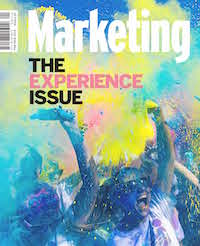Think about your customer’s brand, not your own
Share

Forget developing your brand, advises Steve Sammartino, focus instead on building experiences that help your customers enhance their own.
This article originally appeared in The Experience Issue, our February/March 2018 print edition of Marketing magazine.
The human experience is a curious one.
 A life is a continuous process of collecting things. The first things we collect are the most basic of survival skills – learning to eat, walk and communicate. But as we grow, we learn to collect far more intricate skills and life experiences. We start to collect stuff.
A life is a continuous process of collecting things. The first things we collect are the most basic of survival skills – learning to eat, walk and communicate. But as we grow, we learn to collect far more intricate skills and life experiences. We start to collect stuff.
We’ve done it for millennia. As a survival necessity, we initially gathered food and resources to survive the winter. But as we industrialised, this basic behaviour spilled over into other areas where what we gather was beyond necessity. Today, the indoctrination of the process starts when we’re young.
Early childhood TV shows are stealthily developed with merchandising in mind. Cereal packets with surprise collectable widgets inside compete with a barrage of advertised ‘must have’ toys with a deep fad orientation. The brand marketer wants to ensure children want the new toy just as much as they wanted the – now unloved – toy of last summer, or even last month.
This is something we don’t really grow out of.
The major part of the past 70 years has been about conspicuous consumption and it has been a physical manifestation of our desire to display the skills and abilities we have. Consumption became a cognitive shortcut to tell others that we are worthy. We have skills, and this stuff we’ve collected proves it. This is not surprising, given our entire economic system was built around the production and consumption cycle. We all got paid for making, selling and financing stuff, or teaching our kids the skills they need to be able to acquire stuff as grown-ups.
The ultimate proof point at how good we became at this process, was at the peak of industrialisation when self-storage boxes started to appear in the Western world. In the US, these are worth more than $25 billion in annual revenues and have been the fastest growing form of commercial real estate in developed markets for the past 38 years. Let’s add to this the fact that 70% of people using self-storage facilities live in a free-standing house that even has a garage. Our houses are so full, we’ve started filling up other spaces.
But the end is near as we enter the ephemeral economy, one where what we do is far more important than what we have. In fact, we’ve finally started to realise that the having is really in the doing, and we don’t need a quarter-acre block to store and do things any more.
The truth of what humans want is really simple. We just want to be loved. We want to know everything is going to be OK. We want respect and to live in the belief that we have value as a person and that our society cares for us, and to be part of something at a social level. Historically, our lives have been linear and local. Our value and success could only really be displayed to those in our immediate peer group. But once we start to think about all the technological tools arriving and what they allow us to do, much of it revolves around creating a new era of mobility. We’ve developed a new sense of geographic independence and, in doing so, we can display our worth and value in ways that were not previously possible in the cycle of consumption.
Let’s think about all the new forms of mobility available to us. Smart devices and mobile computing in all its capacities mean everything that can be communicated is.
Wikipedia, blogging and vlogging have created a new era of mobility of information, ideas and creativity, because content is not locked down to the physical location of books or other data sources. Social networks have invented the mobility of connections to people. What we are doing and saying flies across the globe at the click of a button, and it can now fly to people who care about what we care about. The hashtag itself has become a kind of collective sentience that helps us find our cohort.
All of a sudden, the best way to display who we are is no longer what we have, but what we did. What we create and where we go now has far more social currency than what we accumulate. We’ve transitioned from the era of conspicuous consumption to one of ostentatious experiences. And even if we buy something, the first port of call for the modern day maven is to put it all on display. This shift has massive implications for all brand marketers, regardless of industry.
The emerging experience economy is a function of many things. In the first instance, we shouldn’t forget that making stuff and getting it to consumers used to be a hard slog. The company that owned the factory, created a supply chain and could afford to shout it out in mainstream media had an unfair advantage. But with the emergence of a permanent informational connection to everything that makes up the physical economy, anyone can make just about anything without a supply chain.
Everyone is just a few clicks away from more than four million factories on AliExpress and widely distributed brands are having their equity competed away one discount at a time. The future of brands is now moving swiftly away from homogeneous products, and quickly towards services, experience and the malleable market – a market where what we sell isn’t finished until the end user has interacted with it.
This means brand stewards need to have the courage to sell unfinished products.
While it sounds a bit crazy, we need to remember that many of these already exist: my phone, although the same model, is different to yours the day I get it home. My Netflix display is different to yours. My Tesla changes its physical disposition based on where I drive and Alexa has a bunch of different answers based on the data it has about me.
It used to be that a brand either lived in the product or service space. Now, every brand is in the service arena, regardless of how physical the product is. The service element – the personal experience – now becomes a function of the algorithmic response to my interactions with it and the potential for customisation.
But it goes even deeper than that.
With every consumer now the CEO of their own personal media corporation, their first question is ‘how will this experience translate if I post it to my people?’ The thing people now want to accumulate more than anything is peer group validation.
All brands must ask themselves a new question: how does what we sell enhance the brand of the person who purchased it? All of a sudden their brand is more important than yours. The greater the experience orientation of the spend, the greater the chance you get featured on the front page of their digital ‘Life Magazine’. It seems the modern day essential has evolved from food, shelter and a cave full of widgets to the experiences we have.
And all people want to do is send a metaphorical postcard of how good they want people to believe their lives have become.
* * * * *
To purchase a copy of the latest issue or a subscription to the magazine, visit the shop »
* * * * *
Image copyright: gearstd / 123RF Stock Photo















